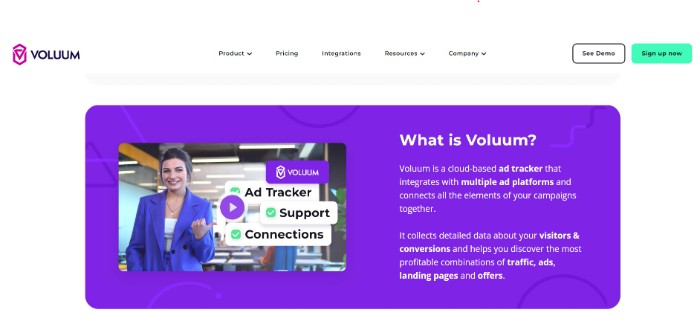Navigating the bustling digital landscape to snag the attention of online viewers is like trying to lasso a shooting star. It's no easy feat, but with the right tools and tactics, it's doable. This brings us to the realm of native advertising, the master of disguise in the marketing universe.
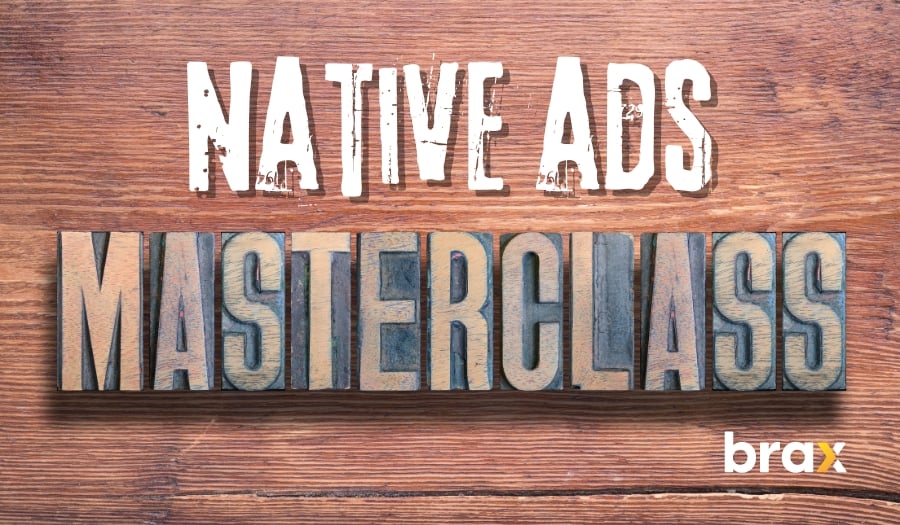
What is Native Ads really and how can you use it for your business? That's what we're going to answer in this post, and then some.
It takes a lot more than a simple guide, so we'll be referring to several posts. Make sure to check those out as well for a thorough understanding of native ads (this is a masterclass, after all!)
In this guide, we'll talk about...
- What is Native Advertising
- Understanding the Different Types of Native Ads
- Designing Effective Native Ads
- Top Native Advertising Platforms to Try
- How to Measure Success in Native Advertising
- Frequently Asked Questions on Native Ads
Feel free to jump to the section you want to learn more about!
What is Native Advertising?
Native advertising, at its core, is a unique form of paid advertising that takes on the look, feel, and function of the media format where they're showcased. It's like the undercover agent of advertising, blending seamlessly into the platform it inhabits.
Whether it's promoted social media posts, sponsored content on news sites, or recommended articles on your favorite blog, native ads are everywhere, and they're changing how businesses connect with their audiences.
Why does native advertising matter in today's saturated online advertising landscape? Because it works. Traditional banner ads scream "I'm an advertisement!" and are often ignored or, worse, blocked. Native ads subtly engage with viewers, offering valuable content without interrupting the user experience.
Let's consider some industry stats. According to eMarketer, native ad spend reached $87.03 billion in 2022 and is expected to grow by over 13.5% this year. That's no small change.
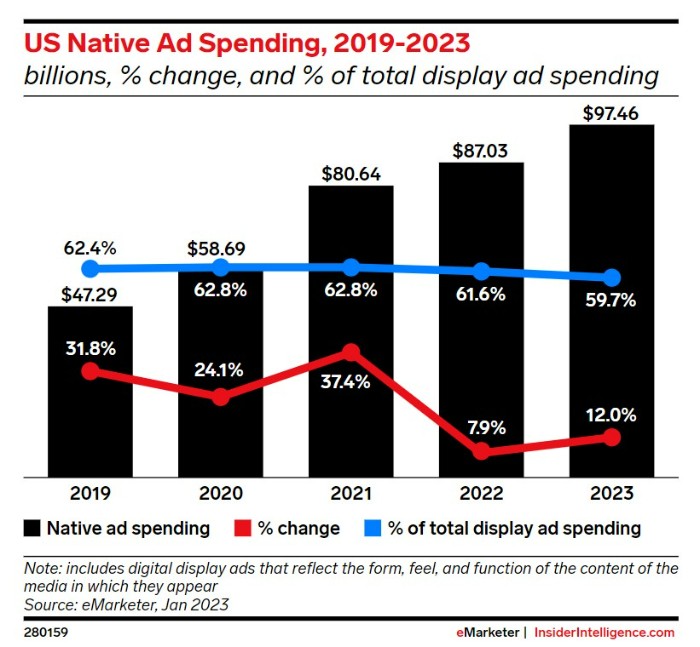
And there's a good reason for this investment. Here are a few studies that show why native ads are better:
- Sharethrough and IPG Media Labs' study found that 53% of consumers looked at native ads more frequently than display ads.
- According to a Nielsen study, consumers are 2.2 times more likely to actually buy the product being advertised.
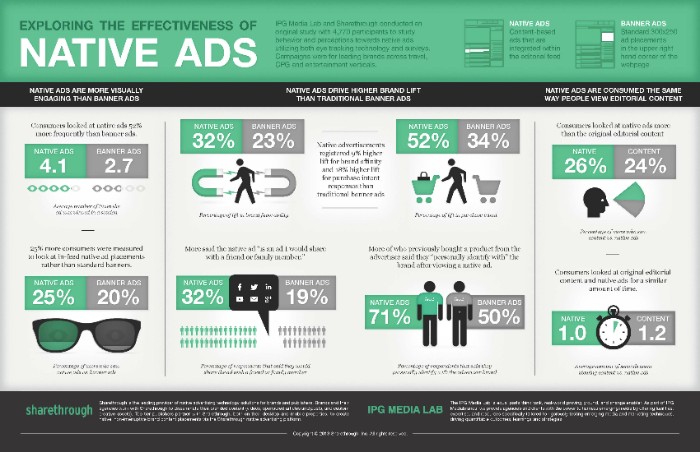
But here's the real secret sauce of native advertising: authentic storytelling.
In a world where consumers are bombarded with sales pitches, authentic stories stand out. They engage, entertain, educate, and inspire. They build connections and foster loyalty.
And when these stories align with the interests and needs of your target audience, magic happens. Your content becomes not just another sales pitch, but a valuable piece of information that enhances the user's experience.
For more details on how Native Ads can benefit you, read our article Why Is Native Advertising An Effective Digital Advertising Technique?
Understanding the Different Types of Native Ads
In the vast ocean of digital advertising, native ads are like the clever octopuses that blend seamlessly into their surroundings. Unlike their cousins, the banner ads, which stick out like neon clownfish, native ads are designed to emulate the feel and function of the content around them.
They come in various forms, including:
Content Recommendation Widgets
These function by analyzing the content you're consuming and then offering up related content that you might find interesting. Sometimes it's similar to the top you are viewing, sometimes not. What's important is that it looks like a content from the same website, even if it takes the user to a different site.
A great example of content recommendation widgets in action can be seen on news websites. Ever noticed those "Recommended For You" or "You Might Also Like" sections at the end of an article? Those are content recommendation widgets, hard at work!
Search & Promoted Listings
Promoted Listings are a specific type of native advertising that sellers use to increase the visibility of their products on e-commerce and digital platforms. They're known as "Sponsored Products" on Amazon and "Promoted Listings" on eBay, among other names on different platforms.
Imagine you're scrolling through an e-commerce platform. You see a list of products, all presented in a similar style. Then, amongst those products, there's one that looks just like the rest, but it has a small "sponsored" or "promoted" label. That's a Promoted Listing. It blends seamlessly into the platform, appearing in the same format as the organic listings.
In-Feed Units
In-Feed Units are those ads that appear within a platform’s natural content feed, fitting seamlessly into the user's viewing experience.
Picture yourself scrolling through your Facebook or Instagram feed. You see posts from friends, family, pages you follow, and then, subtly mixed in, there's an ad that looks just like all the other posts. That's an In-Feed Unit.
It could be the same within a content website's list of articles or blog posts. It can be a sponsored post, a video, an image, or even a carousel of images.
There are a few more types, but these are the most popular ones.
Check our Native Ads Formats article for information on the others.
Designing Effective Native Ads
Now, let's chat about creating killer native ads. You know, the ones that blend so well into the user experience, they feel like a natural part of the content.
Firstly, make sure your ad matches the look, feel, and function of the media format it's in.
It should blend in — not stick out. This includes using the same language and tone as the rest of the content on the platform.
Some native ad platforms provide a list of websites they publish in, sometimes you can even select the exact website. That should give you an idea of how to create your native ads.
Secondly, always deliver value.
Your ad should offer something useful or interesting to the reader, whether it's an insightful article, a helpful tip, or an entertaining video. If you're providing something of value, users are more likely to engage with your ad or offer.
You can't always do that on the ad itself, so make sure you deliver value through your landing page.
Now, let's talk headlines.
A great headline should grab attention and spark interest. Keep it short, clear, and compelling. Use action words and strong verbs. And don't shy away from creating a sense of urgency or curiosity — these are proven methods to draw readers in.
Multimedia elements can also enhance your ad.
People love visuals! Images, videos, infographics — they all help to grab attention and make your ad more engaging. But remember, they must be high-quality and relevant to your content.
Refer to our Top 16 Native Advertising Best Practices (Updated for 2023) for more information on how to better use native ads today.
Examples of Effective Native Ads
Nothing like showing how Native Ads should be like than providing examples, right?
Here's a list of articles for various industries and events complete with native ad examples that we've created over time.
- How to Add a Holiday Twist to your Native Ads
- Promoting Dating Sites and Apps via Native Ads
- How to Advertise CBD Online for Maximum Exposure
- Creative Real Estate Ads that Let You Close Fast
- Native Ads for eCommerce
- VPN Affiliate Programs through Native Advertising
Top Native Advertising Platforms to Try
Now, as for the best native advertising platforms, well, it's subjective - different platforms cater to different needs. However, some of the top players in the game:
1. Outbrain
Outbrain is a leading native advertising platform that allows advertisers to target audiences through personalized recommendations on the world's leading publishers. It offers features like behavioral targeting, custom audiences, lookalike audiences, retargeting, and conversion tracking. It's a great choice for businesses aiming to increase brand exposure and drive traffic.
Pros: Outbrain offers a robust targeting system, high-quality traffic from top publishers, and flexible cost options.
Cons: It could be more expensive than other platforms and might require a higher initial deposit to start a campaign.
Refer to our Outbrain Review for more information.
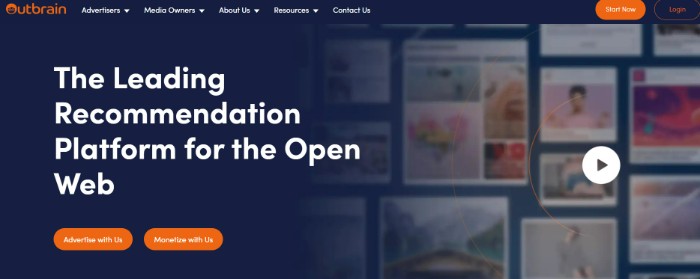
2. Taboola
Taboola is another giant in the industry, serving over 450 billion content recommendations to over 1.4 billion unique visitors each month across premium publishers. Taboola's platform allows you to reach your target audience when they’re most receptive to new messages, products, and services.
Pros: Taboola has a wide reach with access to premium websites, offers a variety of ad formats, and has a user-friendly interface.
Cons: The approval process for ads can be strict and it may also require a significant initial investment.
Refer to our Taboola Review for what we think of this ad network.
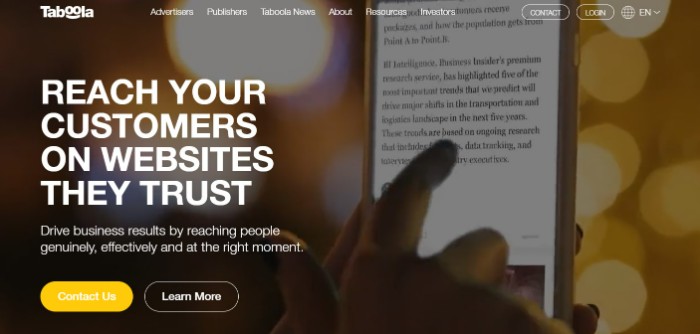
3. Yahoo Gemini
Now known as Verizon Media Native, it's a platform that combines search and native ads for superior results. It allows advertisers to buy, manage, and optimize their mobile, video, and programmatic ads through a single platform.
Pros: It combines search and native ads for broader reach, offers advanced targeting options, and has access to Verizon Media properties like Yahoo and AOL.
Cons: The traffic volume may be lower compared to Taboola and Outbrain, and its interface may not be as intuitive.
Refer to our article on Yahoo Gemini for more information.
4. Nativo
Nativo is a technology platform that provides tools and solutions to scale, automate, and measure native ads. It's ideal for brands and agencies interested in distributing their content more effectively.
Pros: Nativo allows for automatic scaling of native ads, provides detailed performance reports, and supports multiple ad formats.
Cons: It may not be suitable for smaller businesses due to its pricing structure and minimum spend requirements.
5. TripleLift
TripleLift offers programmatic native advertising solutions and is one of the pioneers in native ad exchanges. It uses computer vision technology to analyze and understand the context of the website where the ad will be placed.
Pros: Triplelift offers innovative ad formats, uses AI for contextual relevance, and has partnerships with high-end publishers.
Cons: It may be more costly than other platforms and could have a more complex setup process.
6. RevContent
RevContent is a content discovery platform similar to Outbrain and Taboola. It helps advertisers increase engagement and reach by delivering highly targeted content recommendations.
Pros: RevContent provides highly targeted content recommendations, lower cost per click compared to other platforms, and flexible widget customization.
Cons: The reach might not be as wide as other platforms and quality control can vary.
Refer to our Revcontent Review to see if this network works for your needs.

7. MGID
MGID, a trailblazer in the world of native advertising, is a global platform that fuels revenue growth for all parties in the advertising ecosystem. Recognized for its innovation and user-friendly interface, MGID has been hailed as a top choice for native advertising by users.
Pros: MGID offers a variety of ad formats, wide global reach, and a user-friendly dashboard with detailed analytics.
Cons: The quality of traffic can vary and there might be strict restrictions on certain types of content.
Here are some MGID Best Practices to apply if you'd like to use this ad network.
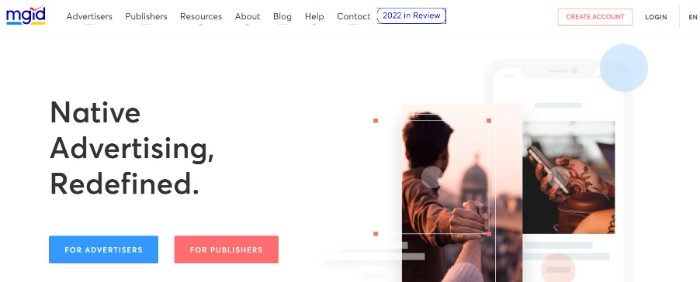
Selecting the right advertising network depends on your unique needs and objectives, such as your budget, target audience, preferred ad format, and performance tracking requirements. Each of these platforms has its strengths, so it's worth exploring each one to see which fits your goals best.
For a comprehensive list of native ad platforms, visit our Ultimate List of Native Ads Providers article.
How to Measure Success in Native Advertising
Here's the kicker: How do you know if your native ad is the James Bond of ads, charming its way into users' hearts (and wallets), or if it's more of a Mr. Bean, bumbling along and missing the mark?
That, my friends, is where measuring success in native advertising comes into play. You cannot generate massive profits without knowing where you're getting the revenue from, after all.
Choosing the Metrics
Now, measuring success in native advertising isn't as straightforward as counting clicks or impressions. Oh no, it's much more nuanced than that.
It's about Key Performance Indicators (KPIs). These are metrics that give you insight into how well your campaign is performing. Here are a few critical ones for native advertising:
- Win Rate: This tells the advertisers how much of the available ads the campaign has won. If you win the bid, your ad will show up on the publishing website. A lower win rate means you have to improve your bid if you want to receive more impressions.
- Click-Through Rate (CTR): This is a nifty little metric that tells you how many folks couldn't resist the allure of your ad and gave it a click. A higher CTR usually means your ad is relevant and engaging to your audience.
- Conversion Rate: This is perhaps the most crucial metric as it shows how many people performed the desired action (like purchasing or filling out a form) after clicking on your ad.
- Return on Investment (ROI) or Return on Ad Spend (ROAS): This is another crucial metric as it tells you whether running native ads for your brand or business is worth it.
Tracking and Management Options
Let's say you already know the KPIs you want to track. How then can you do the actual monitoring? From campaign creation to performance tracking, various native advertising management tools can make your life significantly easier.
They offer features like multi-platform management, real-time analytics, rules-powered optimization, and detailed reporting to ensure you're getting the most out of your native advertising efforts. Here are some of the best ones.
Brax
Imagine having a tool that allows you to see all your campaign data in one place. Well, folks, Brax is that tool. It's your control center for managing native ad campaigns across multiple platforms. When it comes to managing native ads campaigns, Brax is the cream of the crop.
With it, you can compare, contrast, and optimize performance across different platforms without breaking a sweat. Think of it as having your very own marketing dashboard. To top that off, your campaigns can even run on their own through Rules-Based Optimization.
Want to see this tool in action? Book a free demo today and be blown away by how it can help you with your native ads.
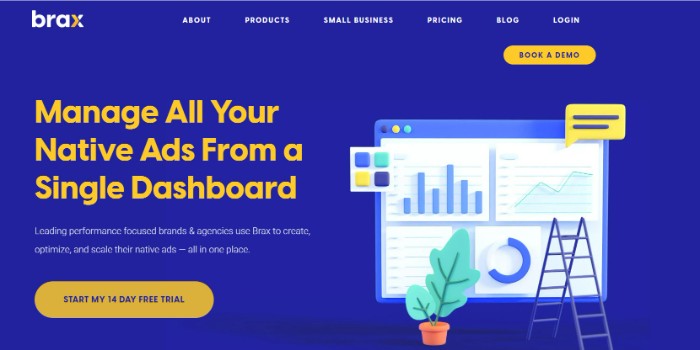
Voluum
This tool is like your personal fortune teller, providing real-time analytics that allows you to peek into the future of your campaigns. But it doesn't stop there. Voluum comes with AI-powered optimization tools. So, not only can you track almost any performance metric, but you can also let artificial intelligence do the heavy lifting for you.
However, native advertising isn't the only ad type that Voluum monitors, which means some systems are generic and not focused on native ads alone.
Google Analytics
Now, who hasn't heard of Google Analytics? This tool can provide a wealth of data about your website traffic. Want to know who's visiting your site? Check. How about how they're getting there? Double-check. And what they're doing once they land? Triple check!
It's like having a security camera that constantly monitors your website, giving you all the intel you need. The upside? It's free to use. The downside? You'd have to set everything up manually, even adding your custom metrics and calculation one by one.
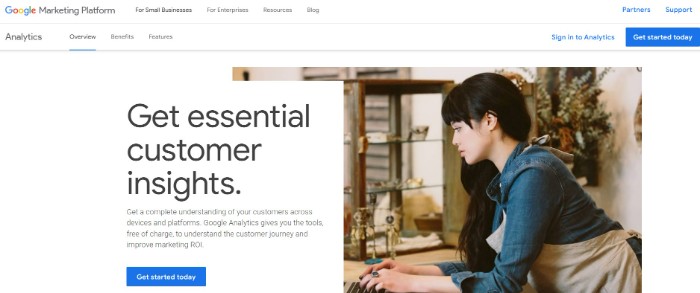
So, you've run your campaign and collected lots of data — now what? Well, now it's time to analyze the results. Look at your KPIs and see how they stack up against your goals. A successful campaign will meet or exceed these goals. If they don't, then you must optimize.
While the tools mentioned above are mostly for tracking, optimizing is typically a separate function. The only one in the tools above where optimization is also possible is Brax.
Here are the Top 4 Native Ads Optimization Tools in 2023 for your reference.
If your campaign wasn't as successful as you'd hoped, don't despair! Use the insights you gained to optimize future campaigns. Maybe you need to tweak your targeting, or perhaps your messaging wasn't quite right. Remember, marketing is all about testing, learning, and improving.
Frequently Asked Questions on Native Ads
Are native ads worth it?
Absolutely! Native ads are definitely worth it as they seamlessly blend into the platform they're on, resulting in a more engaging and less disruptive user experience.
How much does it cost to run native ads?
On average, you might expect to pay anywhere from $0.10 to $10 per click for native advertising. The cost of running native ads can vary widely based on factors such as the platform you choose, the scope of your campaign, and your target audience.
Does native advertising help SEO?
Yes, native advertising can indirectly benefit SEO. While the ads themselves don't directly improve organic search rankings, the increased traffic, engagement, and brand exposure they generate can lead to more organic backlinks and social shares, which are beneficial for SEO.
Is Native Advertising ethical?
Native advertising is considered ethical as long as it adheres to transparency standards, such as clearly disclosing that the content is sponsored or paid for. The key is to ensure consumers are not misled and can distinguish between editorial and advertising content.
Wrapping Up
It's clear that native advertising is a powerful tool in the digital marketing landscape. By seamlessly blending into the user experience, it provides an engaging and non-disruptive way for brands to connect with their target audience.
However, remember, the key to successful native advertising based on how experienced affiliates do it lie in ensuring transparency, maintaining authenticity, and providing valuable content that enhances the user journey. This is how you squeeze maximum revenue from your marketing strategies.
So go forth, use use what you've used in this native ads master class, and watch your business reach new heights. After all, in the world of modern marketing, being native is being noticed!
